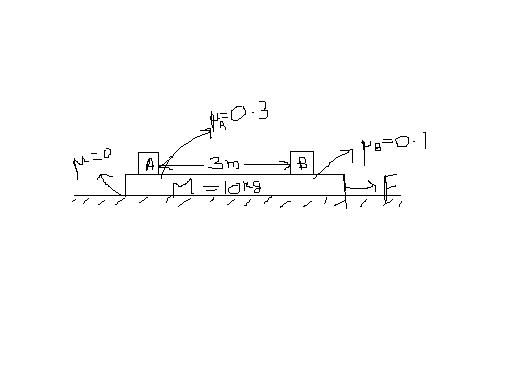no wrong!!
the ans is 6s.
A plank of mass 10 kg rests on a smooth horizontal surface . Two blocks A and B of masses m = 2kg and m = 1 kg resp. lie at a distance of 3 m on the plank as shown in the figure . The friction coeff. b/w the blocks and plank r 0.3 and 0.1 . Now a force F = 15 N is applied to the plank in horizontal direcn . Find the time ( in sec ) after which block A collides with block B .

oh yeah.. calc mistake
Considering the plank and the blocks to be a system,
F=m.a
15N = 13.a
a=15/13 ms-2 [ a is the acceleration of the system]
Now, considering the blocks...
Block A
f ≤ μN
≤ 0.3 * 20 ≤ 6N
Force acting on the block due to motion of plank,
F= m.aA = 2.15/13 = 2.30 N
Hence, force of friction balances this force and hence there is no relative motion between the block A and the plank.
Block B
f ≤ μN
≤ 0.1*10 ≤ 1 N
Force acting on the block = m.aB = 1*15/13= 1.153N
Net force,
m.aB= 1.15 - 1
= 0.15
aB= 0.15/1
Time taken ≈ 6s
Considering the plank and the blocks to be a system,
F=m.a
15N = 10.a
a=3/2 ms-2 [ a is the acceleration of the system]
Now, considering the blocks...
Block A
f ≤ μN
≤ 0.3 * 20 ≤ 6N
Force acting on the block due to motion of plank,
F= m.aA = 2.3/2 = 3N
Hence, force of friction balances this force and hence there is no relative motion between the block A and the plank.
Block B
f ≤ μN
≤ 0.1*10 ≤ 1 N
Force acting on the block = m.aB = 1*3/2 = 1.5N
Net force,
m.aB= 1.5 - 1
= 0.5N
aB= 0.5/1
Time taken = 2√3 sec.
..how r u doin F = (sum of mass)*a here?? its wrong...
it should be 15 - fr1 - fr2 = 10a (a acc of plank)..
fr1=M1(a-B)
fr2=M2(a-b)
|B-b| gives relative accleration
actually the magnitude of friction depends upon acc. of the plank...where it itself depends upon the friction....can sm1 say if i m ri8??
i think i cant take fr1 or fr2 as Fmax....
see if fricn was absent
then commom acc. wud hav been 15/13 m/s2
now if its there B will slip.......
for A and M , common acc. is 14/12 ( net force = 15 - 1 )
for B acc. is 1.
relative acc. = 14/12 - 1 = 1/6.
rel. displacement = 3.
so s = 1/2 a t2
and t = 6s...
so the ans is not almost 6
it is exactly 6..
@AKHIL...this is nt true
".see if fricn was absent then commom acc. wud hav been 15/13 m/s2"
if there wer no friction mass M wil be goin wid acc 1.5 m/s2..nd block A nd B would be in rest w r t the ground.....or will be goin wid an acc 1.5 m/s2 w r t block M..
here friction between block B and plank is 1 N,wich is max friction,(as 15N>11N)..and friction between block A and plank is adjusting friction..so acc. of block A is 7/6...so relative acc 1/6.....and T = 6